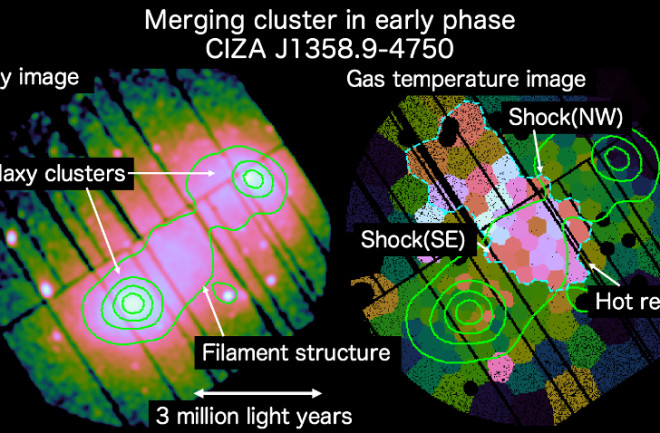A new paper opens a window on the largest astronomical event in the known universe: the merging of two galaxy clusters. It finds that during the galactic crunch, just one side exerts as much energy as a billion suns burn in a year – and does so every second.
Galactic clusters are massive collections of galaxies bound together by gravity. (We in the Milky Way belong to the Laniakea Supercluster.) They include both galaxies and clouds of gas, which mix together vigorously when two clusters collide. The gas typically becomes the star of the show since stars don’t normally collide when groups of galaxies merge.
A Newborn Collision of Galaxy Clusters
A group of researchers spotted a pair of galaxy clusters a billion light-years from Earth that have just begun to collide, meaning the show’s just getting started.
To study the event, they drew upon observations from Suzaku, a Japanese X-ray astronomy satellite. The clouds of high-temperature gas inside each cluster emit X-rays and allowed the team to map out the collision.
Next, the researchers pulled data from the European Space Agency's space observatory XMM-Newton, which is more powerful. The observations showed a clear “bridge” about 1.5 million light-years across, linking the two clusters. That’s a large distance by most measures – the sun is only about 26,000 light-years away from the galactic center – but when it comes to galaxy clusters, that’s a tight squeeze.
As such, the gas had already heated itself to about 72 million degrees Fahrenheit inside the clusters and to about 108 million F within the bridge. As part of the superheated collision, immense shock waves had formed coming from each direction, and the team set about estimating their size and power.
They derived some mind-boggling numbers.
Read More: Black Hole Theory Finally Explains How Galaxies Form
A Billion Suns
“These shock waves have a width and depth 30 times larger than the diameter of our Milky Way galaxy,” said Yuki Omiya, a doctoral student at Nagoya University, in a statement.
But they wanted to know more about the sheer energy expended by the shock waves. That meant quantifying their speed and applying it to what they already knew about the waves’ dimensions.
The team analyzed the temperature distribution within the hot gas to estimate the velocity of the shock waves. They were traveling at about 930 miles per second, a number the researchers used to calculate the sheer force involved in just one of the waves. Every second, the wave consumes about as much energy as a billion suns would burn in a year.
Where does it all go? To heating gas, altering magnetic fields and accelerating particles close to the speed of light.
Read More: 10 Facts You May Not Know About the Milky Way
When Will the Collision End?
In 300 million years, the researchers estimate, the collision will have concluded, resulting in a single galaxy cluster.
In the meantime, they hope to further study the process by using Japan’s new X-ray satellite, XRISM, once it launches – the Japan Aerospace Exploration Agency postponed its liftoff on Sept. 3, 2023.
With XRISM, “We will be able to capture the turbulent nature of the high-temperature gas generated by the motion of the shock waves for the first time,” said Omiya.
Read More: Most Distant Galaxy Cluster Ever Found Helps Show How the Universe First Lit Up

